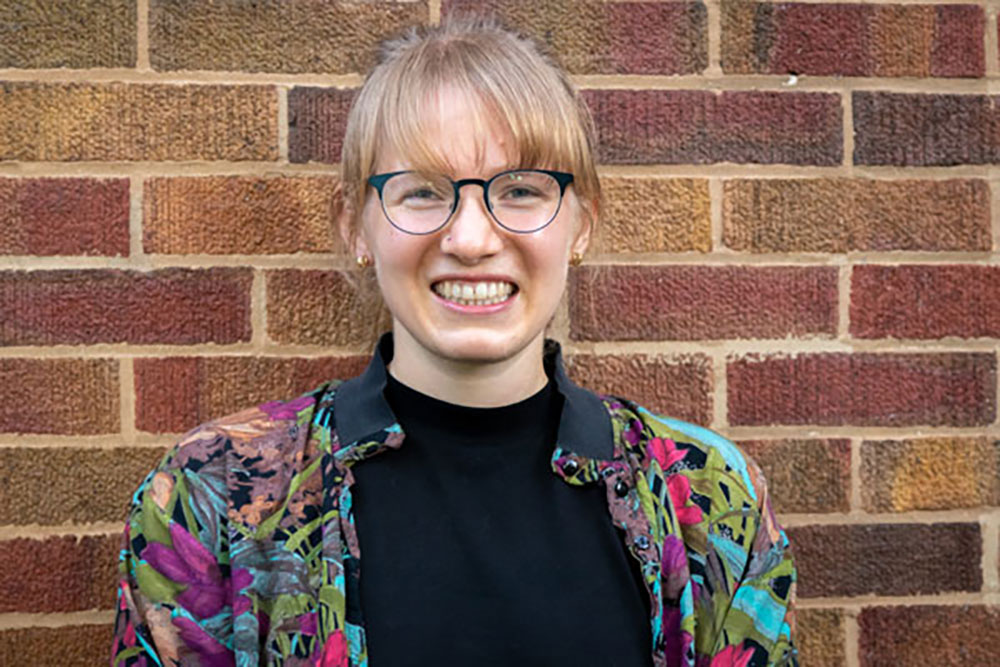Kelsey DiPietro is accelerating research through her work in computer models.

In the world of multigigabit high-speed internet, pre-ordered fast food and Twitter pitch events, there is little patience for slow computer models — especially ones used to combat the Earth’s rapidly changing climate. To address this, Kelsey DiPietro, a Jill Hruby Fellow appointed at Sandia in 2019, has created algorithms that make computer models of complex systems more efficient by skipping over areas of datum where there is little change and honing in on those with observable shifts.
Kelsey, an applied mathematician with a doctorate from the University of Notre Dame, has made advances in creating fast 3D computational algorithms, with the aspiration of integrating them into DOE’s supercomputer-powered Energy Exascale Earth System Model, or E3SM.
“These advances will make them more tractable, or more easily solvable in a reasonable amount of time, and that is really key for my current project at E3SM where precise models can take an impossible amount of computation to solve,” she said.
She said in computational modeling, researchers adjust their models based on feedback they receive from the experts on her team, which consists of 100 researchers from eight DOE labs and several universities.
“We frequently start with very simplified models of a natural phenomenon, and then rely on other researchers to help validate how realistic or accurate our models may be,” Kelsey said. “We can create fast models all day, but if they don’t provide enough information or accurate enough information for our partners, then the model is not useful. It is a really dynamic relationship.”
The developments Kelsey has made during her time as a Hruby Fellow will allow her to take a previously intractable problem and apply it to adaptive digital meshes that can be manipulated into different shapes and forms and then refined based on user-specified criteria for existing Earth modeling applications.
“My advances will allow for easier integration without any prohibitively expensive computational costs,” she said. “This approach could be used for a wide range of applications, but there are certain problems where use of this model is more straightforward. For example, it’s much easier to target a problem that evolves on a slow time scale, such as moving ice sheets, than something on a short time scale, like a flash flood.”
The E3SM project, concluding in December, has been developing models and simulations that consider the interactions between the water cycle, the Earth itself and the atmosphere, known as Earth-system science drivers. The data for these three drivers is supplied by researchers from different disciplines, and this diversity is what fuels innovation, Kelsey said. “The diverse educational background of people involved in the project — physicists, engineers and mathematicians — helps bring a wide range of ideas.”
Diversity aids in solving scientific problems
Kelsey said diversity spurs questions that lead researchers toward new solutions. She credits the diversity of researchers working on E3SM with helping push her project forward.
“Research is constantly pushing you to think outside of the box, but if everyone starts off in the same — or a very similar — box, then it’s hard to arrive at different conclusions or future avenues for your work. Since we are constantly trying to push the bounds of computational research, diversity of thoughts and ideas are crucial in creating pathways forward.”
When it comes to increasing diversity of gender, Kelsey believes that exposure to science, technology, engineering and math is crucial for women.
“Many of my high school educators discouraged my choice to take STEM Advanced Placement classes, which led to a lot of personal doubt,” she said. “Fortunately, in university, I had several professors take note of my talent and encourage engagement in math and science. I still fondly think of my Calculus 2 professor, who not only told me that I had a natural aptitude for the subject but also showed me many of the interesting things math research could do.”
Since entering the scientific professional community, Kelsey has been encouraged by seeing more women attending research conferences.
“Women in mathematics are motivated to organize and get together,” she said. “I’ve been very lucky to participate in several Association for Women in Mathematics networking events and dedicated conferences. These events consistently remind me that even though we may be far from the majority in our field, we are not alone. Our problem isn’t intractable.”